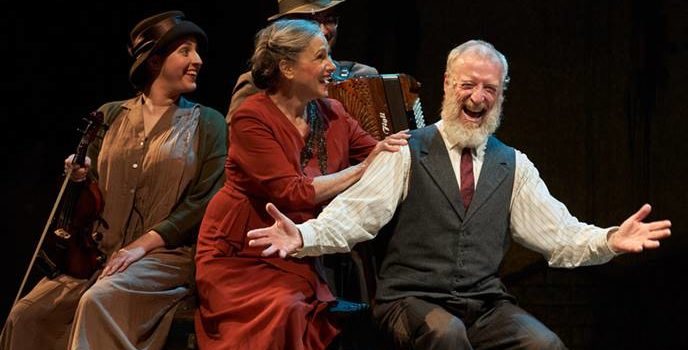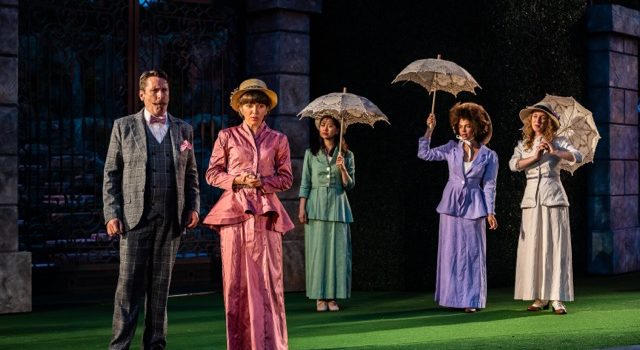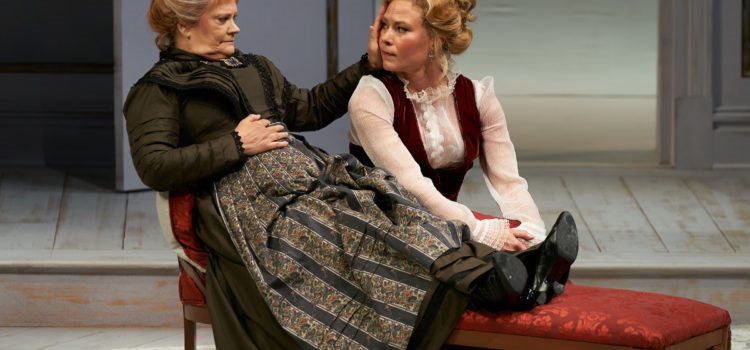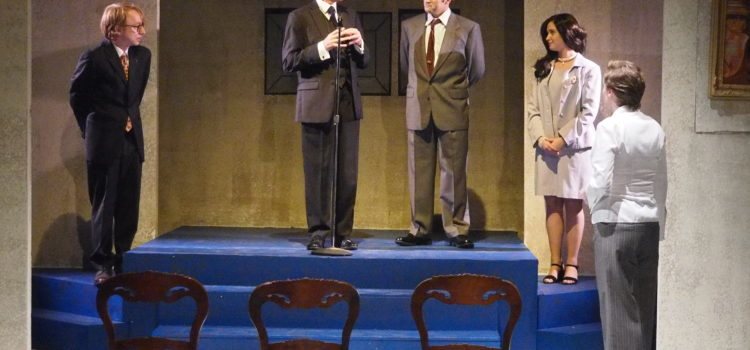By Andrea BraunContributing WriterIndecent (2017) by Paula Vogel tells the story of a play written by the young Sholem Asch entitled God of Vengeance, first performed in 1907. It is presented as his first play, but it is actually his second; however, this and other departures from fact are described by Vogel as “emotional truth,” rather than absolute historical accuracy.
“Vengeance” ran in Germany in the original Yiddish and
was translated and traveled to several other countries, but then came America. At
first, Asch’s play ran off Broadway and stayed more or less under the radar.
But when it moved uptown to the Apollo and the general public was going to be
courted to buy tickets, as Vogel tells it, the script was changed without
Asch’s knowledge or permission because it contained “unacceptable” material.
Photo by Dan DonovanFor example, a Jewish man makes his living owning a
house of prostitution while he and his wife and “virginal” daughter occupy an
apartment upstairs. This was considered by American Jews to be anti-Semitic,
since the Jewish procurer was a stereotype and would be reinforced in the
general public’s mind. So would the focus on making money any way possible. At
one point, he becomes so furious he destroys a holy Torah, a great sin in
Judaism. But most controversial of all was what became known as “the rain
scene,” in which the daughter kisses one of the prostitutes and they proclaim
their love. To middle-class Americans, this is pornographic filth.
Photo by Dan DonovanAsch is so depressed he can’t leave his house.
Finally, his loving and patient wife talks him into attending a rehearsal, but
to him, the play is dead. The longtime stage manager, Lemml (Lou) also
considers this is a disaster, and it’s something they just cannot understand.
Even stranger, the play is closed down by the police and the actors are
arrested and tried, but the playwright and Lemml are not. Lemml tells Asch that
he is going to take the play back to Poland and translate it back into Yiddish.
He tells Asch, “I am tired of being in a country that laughs at the way I
speak. They say America is free? What [sic] do you know here is free?”
And so he does and his troupe performs the play in
cafes, attics, basements—anywhere that will have them until the Holocaust
decimated the European Jewish community of artists and patrons. Asch himself returns after he’s received an
“invitation” from the House Un-American Activities Committee in the 1950s to
live in London and write prolifically until he literally dies in the saddle, at
his desk, writing. Before he leaves, he meets a young scholar from Yale whom he
tells that he, Asch, “lost six million [who] have left the theater.”
Photo by Dan DonovanThat’s the plot, but now comes the hard part: telling you about the production, which is indescribably beautiful (but I’ll try to describe it anyway). I haven’t listed the names of actors who play the characters because they are all played by seven extraordinary performers who not only tell the story through words but also through song and dance.
They are accompanied on stage by a group of three Klezmer musicians, who play a violin, bass clarinet, and accordion to help express both the sadness and joy the audience and characters are experiencing. I’ve only seen four of the actors listed below (Judi Mann, Tim Schall, John Flack, and Paul Cereghino) but I’ve never witnessed any of them stronger or more sure of the material which makes them turn into other people on a dime.
Photo by Dan Donovan
The evocative music is directed by Ron McGowan, Ellen
Isom choregraphs, Phillip Evans gets credit for sound, and Menachem Szus is the
Yiddish dialect coach.It is a clever conceit to have titles on the rear wall to
help us know where we are, and to have the actors use perfect English to speak
their native languages and accented English when they are speaking a second or
third language. The action spans Warsaw from 1906 to Bridgeport, Connecticut in
the 1950s, and as the program notes, “everywhere in between.”
It’s difficult to write about Indecent without gushing, and I don’t think I managed it. But you
know what? It’s brilliant in every way, so a little gushing is justified. It is
both timely and timeless, and I hope you’ll go see for yourself.
Max and Louie Productions presents “Indecent” at the Grandel Theatre through June 30. Tickets are available through Metrotix and more information is available at www.maxandlouie.com
Photo by Patrick HuberThe
Troupe
TJ
Lancaster: Lemml, The
Stage Manager; Paul Cereghino: The
Ingenue: Avram/Ensemble; Zoe Farmingdale:
The Ingenue: Chana/ Ensemble; John Flack:
The Elder: Otto/Ensemble; Katie Karel: The Middle:
Halina/Ensemble; Judi Mann: The
Elder: Vera/Ensemble; Tim Schall: The
Middle: Mendel/Ensemble
The
Musicians
Alyssa Avery: Nelly Friedman/Violin/Ensemble; Kris Pineda: Moritz Godowsky/Accordion/Ensemble; Jack Theiling: Mayer Balsam/ Clarinet & Mandolin/Ensemble
Photo by Patrick Huber

Lynn (Zipfel) Venhaus has had a continuous byline in St. Louis metro region publications since 1978. She writes features and news for Belleville News-Democrat and contributes to St. Louis magazine and other publications.
She is a Rotten Tomatoes-approved film critic, currently reviews films for Webster-Kirkwood Times and KTRS Radio, covers entertainment for PopLifeSTL.com and co-hosts podcast PopLifeSTL.com…Presents.
She is a member of Critics Choice Association, where she serves on the women’s and marketing committees; Alliance of Women Film Journalists; and on the board of the St. Louis Film Critics Association. She is a founding and board member of the St. Louis Theater Circle.
She is retired from teaching journalism/media as an adjunct college instructor.






